Top 5 AI Optimization Agencies Helping Brands Rank in ChatGPT & AI Search
Simran Kataria

In today’s fast-paced B2B world, startups can’t rely on traditional outreach alone. Buyers spend an estimated 27% of their decision-making process conducting online research, and more than 64% of new‑age B2B buyers now prefer digital touchpoints over in-person channels. If you're a B2B startup aiming to grow, digital marketing is your secret weapon—and this guide will help you wield it with precision.
B2B digital marketing refers to the set of online strategies used to connect with other businesses. This includes everything from SEO and content marketing to social media outreach, email campaigns, paid ads, and automation. The goal: attracting prospects, educating them, nurturing relationships, and ultimately turning them into loyal customers in an often lengthy, multi-stakeholder sales cycle.
For early-stage B2B startups, brand awareness and credibility are built one piece of content, one link, and one campaign at a time. Digital marketing empowers you to:
The B2B buying process isn’t linear—and it’s certainly not quick. For startups, understanding how and why business buyers make decisions is essential to crafting effective digital marketing strategies. Each decision-maker may be influenced by different content, metrics, and platforms. Knowing when and how to show up makes all the difference.
Every B2B purchase journey typically unfolds in three core stages:
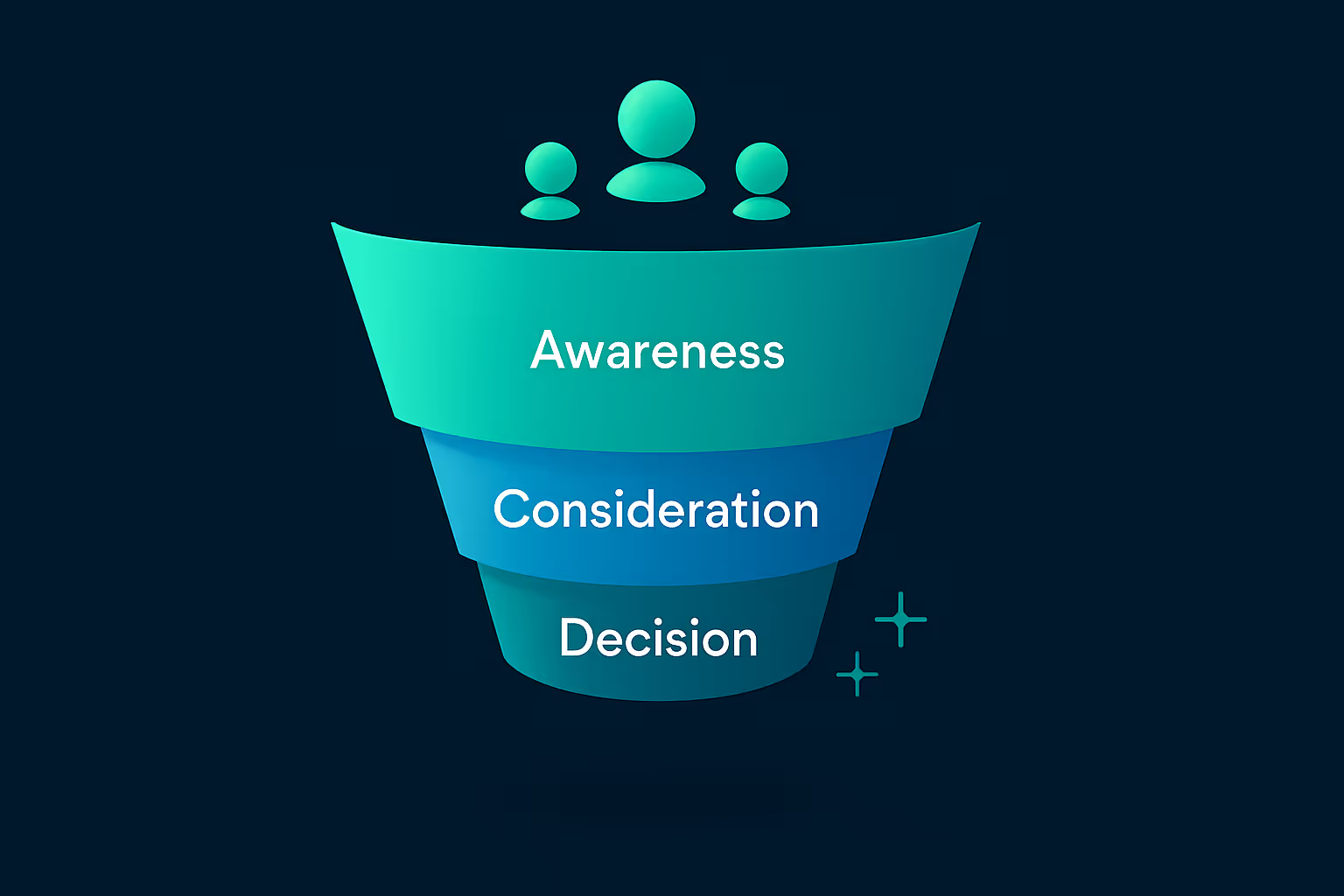
1. Awareness: At this point, the buyer realizes they have a problem but isn’t sure what the solution looks like. They start researching—often through Google searches, online communities, or reading blog posts and reports. This is your moment to show up with helpful, keyword-optimized content like blog articles, explainer videos, or thought leadership posts.
2. Consideration: Now that the problem is defined, the buyer is actively evaluating potential solutions. Webinars, whitepapers, in-depth guides, and product comparisons work well at this stage. Content should demonstrate expertise and build trust.
3. Decision: Here, buyers are shortlisting vendors or tools. Case studies, testimonials, product demos, pricing pages, and persuasive email campaigns can tip the scale in your favor.
B2B deals often involve multiple decision-makers—finance, operations, IT, marketing—and the sales cycle can stretch from weeks to months. That’s why startups need strategies that address each stakeholder’s pain points through personalized messaging and multi-channel engagement.
B2B purchasing is a team sport: Gartner reports that the typical buying committee for complex B2B solutions now ranges between six and ten decision‑makers. Each stakeholder reviews around four to five independent sources before the group reaches consensus. This means prospects arrive well-informed—and often misaligned—making a coordinated digital strategy critical.
Startups that succeed in mapping their content and campaigns to this buyer journey—while remaining agile enough to pivot based on real-time feedback—position themselves as credible partners from day one.
Before you launch ads, publish content, or build landing pages, one thing must be crystal clear: who you are and who you serve. Without clarity in brand positioning and audience targeting, even the best digital marketing tactics can fall flat. For B2B startups, this foundational strategy is non-negotiable.
Your brand positioning isn’t just your logo or tagline—it’s the promise you make to your customers, the unique space you occupy in their minds. In the B2B world, this positioning must convey credibility, capability, and specificity.
Ask yourself:
A strong value proposition should be concise, benefit-oriented, and tailored to your ideal customer. Take Drift, for example. Their messaging—“The new way businesses buy from businesses”—immediately signals innovation and relevance for their audience.
Your digital marketing won’t hit the mark unless it’s laser-focused on the right audience. Start by developing 2–3 detailed buyer personas based on your product-market fit. These personas should include:
Use tools like HubSpot, Nutshell, or Zoho CRM to analyze early client data and uncover trends. You can also glean insights from LinkedIn, sales calls, and feedback from beta users.
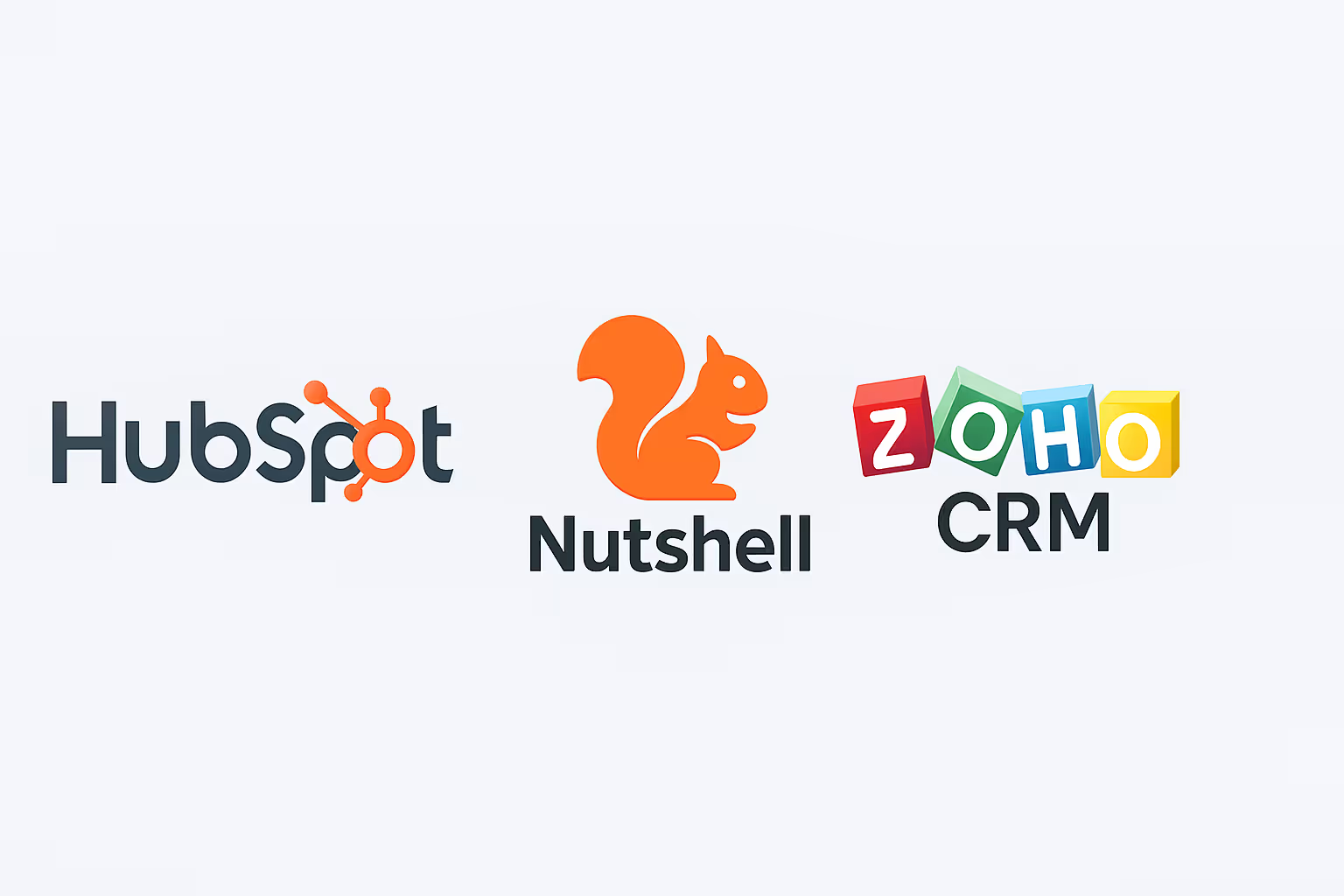
Once you know your audience deeply, your messaging, visuals, and offers become far more compelling. You stop shouting into the void and start speaking directly to the people who need your solution the most.
Positioning and targeting are the building blocks of scalable digital growth. They ensure that every tactic—from SEO to social media—is rooted in relevance and resonance.
Your website isn’t just your digital storefront—it’s your first salesperson, your lead magnet, and often, your first impression. For B2B startups, a high-performance website is mission-critical. It’s where prospects go to validate your credibility, explore your expertise, and decide if you're worth their time.
Unlike traditional website builders, Webflow offers the flexibility of custom-coded design without the complexity or cost. It allows startups to create sleek, fast, and fully responsive websites that evolve with the business.
What makes Webflow ideal for B2B startups:
Startups like Lattice, Attio, and Petal have used Webflow to design modern, conversion-optimized websites that grow with their brand.
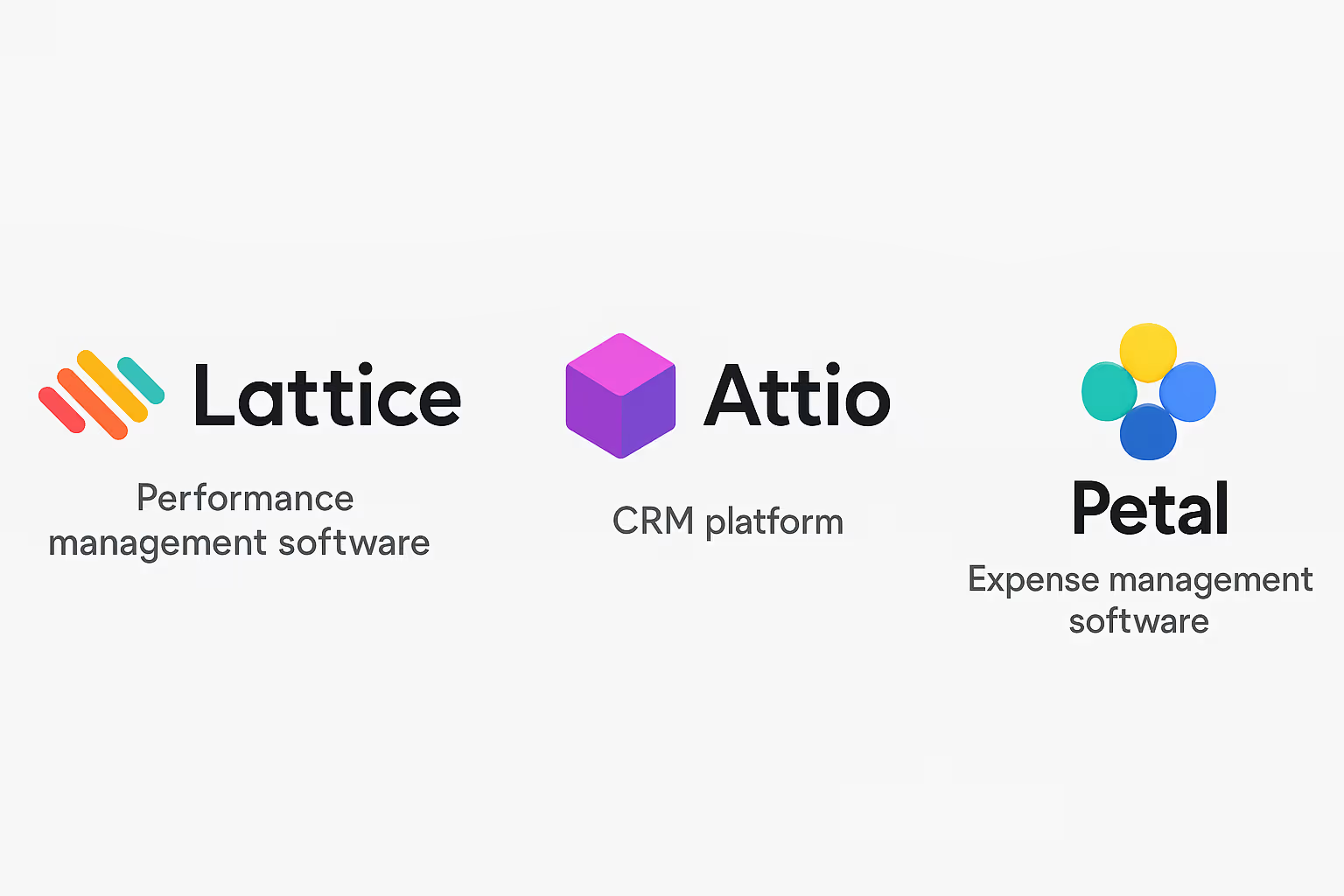
First impressions matter. According to research from Stanford, 75% of users judge a company’s credibility based on its website design. That’s why every element—structure, visuals, copy, and interactivity—should work toward the same goal: converting qualified visitors into leads.
Essentials of a high-converting B2B website include:
Remember, your website doesn’t just need to look good—it needs to perform. Every pixel should drive engagement, trust, and action.
Search engines are the front door of the modern B2B sales funnel. According to HubSpot, 71% of B2B researchers start their research with a generic search. That means if your startup isn’t showing up on page one, you’re missing out on high-intent, ready-to-learn prospects. Search engine optimization (SEO) ensures you’re discoverable—and credible.
SEO can seem intimidating at first, but it’s built on a few fundamental principles that are essential for B2B startups:
SEO success isn’t just about keywords—it’s about trust. Google favors sites that demonstrate Expertise, Authority, and Trust (E-A-T). Startups can build this in two ways:
On-page SEO: This includes publishing in-depth blog content, using schema markup for rich snippets, and ensuring site structure supports search bots. Regularly update old content to maintain freshness and accuracy.
Off-page SEO: This is where link-building comes in. Reach out to industry blogs, get quoted in publications, and guest-post on relevant platforms. Backlinks from high-authority domains act as digital endorsements for your startup.
Clearbit significantly boosted its SEO presence by adopting a data-driven SEO playbook, including tactics like split testing and guest content. As detailed in their "Data‑Driven Marketing" guide, Clearbit optimized landing pages and blog posts with targeted keywords, A/B tested copy and meta elements, and selectively aligned with trusted industry publications for guest contributions
SEO is a long game, but for startups with limited paid ad budgets, it’s a powerful, compounding source of qualified traffic. Done right, it delivers continuous, cost-effective growth.
In B2B, content isn’t just king—it’s the entire court. Great content builds authority, nurtures trust, educates buyers, and supports every stage of the sales funnel. For startups, content marketing is one of the most cost-effective ways to level the playing field with bigger, better-funded competitors.
Content marketing starts with strategy. Begin by mapping out the buyer’s journey and brainstorming content topics that align with each phase.
Top-of-Funnel (Awareness): Create educational blog posts, industry reports, and explainer videos that address buyer pain points. Focus on attracting organic search traffic and building trust.
Middle-of-Funnel (Consideration): Offer whitepapers, webinars, comparison guides, or checklists. This is the phase where prospects evaluate their options. Your content should demonstrate subject matter expertise and strategic thinking.
Bottom-of-Funnel (Decision): Publish case studies, customer testimonials, and product demo videos. Help prospects visualize success with your solution.
Use a simple editorial calendar to organize publishing dates, keywords, formats, and distribution channels. Tools like Trello, Notion, or Airtable are excellent for startup teams.
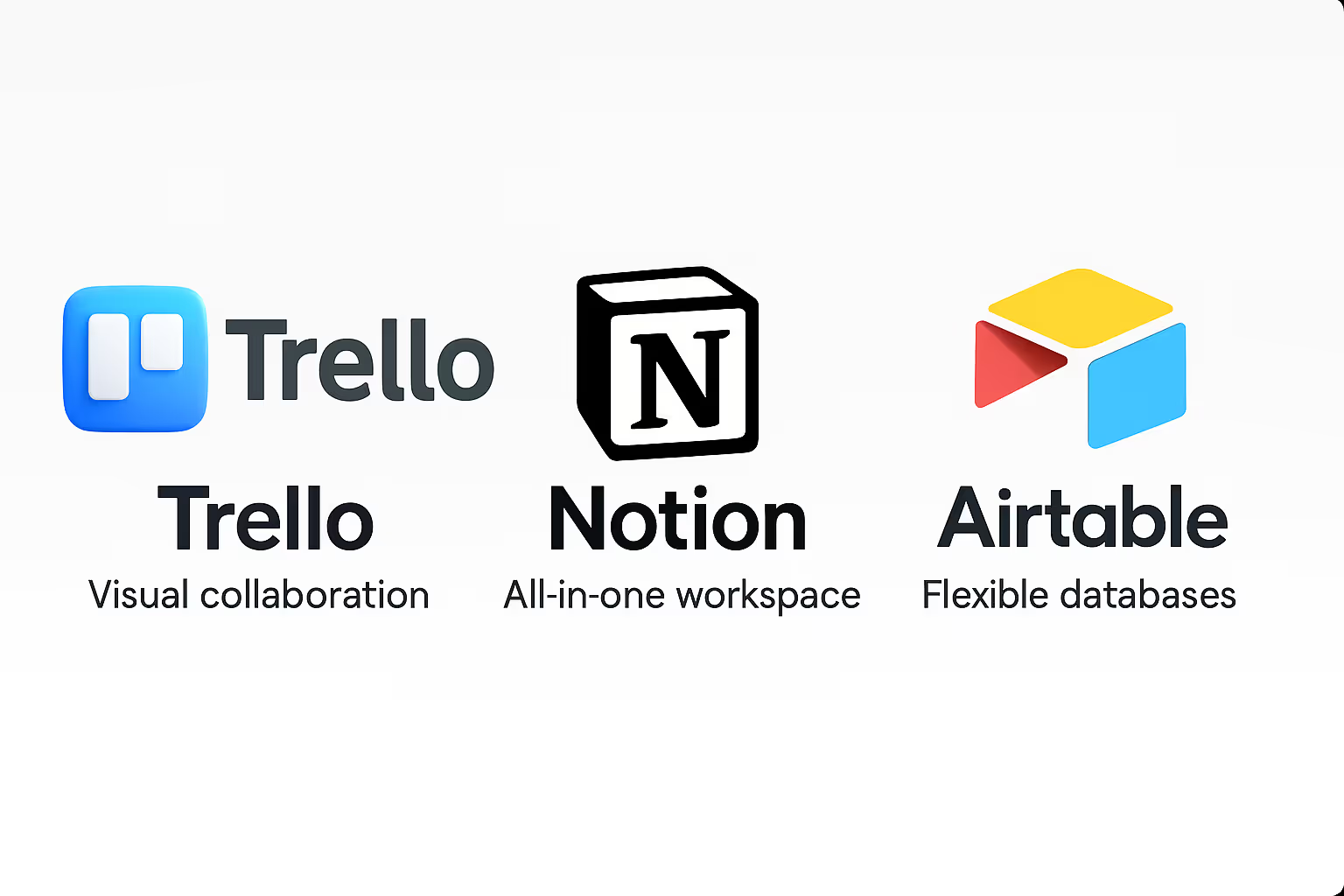
Don’t just blog for the sake of blogging. Focus on publishing content that’s data-driven, deeply insightful, and problem-solving.
Blog posts: These are your SEO workhorses. Write long-form, high-quality articles that answer specific industry questions. For instance, “How to Build a Sales Funnel in HubSpot for B2B SaaS” is far more useful than a generic “Marketing Tips” post.
Case studies: Share detailed success stories from early adopters. Outline the problem, your solution, and the measurable results. This format is especially powerful during the decision stage.
Webinars and video: According to Wyzowl, 86% of marketers say video has helped them generate leads. Webinars let your team showcase expertise in real time while collecting leads through registrations.
Lead magnets: Create downloadable guides, toolkits, or templates that address urgent business needs. Gate them behind forms to grow your email list.
Real-world example: Notion's rise in the B2B space is in part due to its extensive knowledge base, community forums, and customer success stories—all forms of content marketing that turn users into advocates.
Content marketing not only brings people in—it keeps them engaged. It’s the glue that holds your inbound marketing strategy together.
Social media is no longer a “nice-to-have” in B2B—it’s a core pillar of visibility, authority, and lead generation. While platforms like Instagram and TikTok might dominate B2C buzz, LinkedIn, YouTube, and even X (formerly Twitter) are where B2B conversations happen. Startups that master these platforms don’t just build brand awareness—they drive real business results.
Start with where your audience already hangs out. For most B2B companies, that means:
LinkedIn: The undisputed leader for B2B. Share blog posts, micro case studies, and thought leadership pieces. Engage with prospects through comments and DMs. Founders should also post regularly on their personal profiles—startup brands grow faster when the humans behind them are visible.
YouTube: Educational video content like “how-tos,” product walkthroughs, and explainer animations work well here. Consider repurposing webinar content into bite-sized video segments.
X (Twitter): It’s still valuable for tech startups, VCs, and SaaS businesses. Use it for live updates, thought snippets, and industry banter. Engage with trending hashtags or ongoing threads in your niche.
Whichever platforms you choose, stay consistent. Startups with erratic posting schedules and unpolished visuals often erode trust instead of building it.
In B2B, people don’t just buy from businesses—they buy from experts. And the fastest way to build that perception is by empowering your team to speak on behalf of your brand.
Employee advocacy is when your team shares your company’s content on their personal channels. This increases reach, credibility, and engagement. A LinkedIn post from your CTO about solving a unique problem will often outperform a generic company update.
Founder-led social is also powerful. Founders who share lessons, failures, insights, and successes build personal brands that naturally amplify the company brand. Think of how much attention founders like Rand Fishkin (SparkToro) or Jason Fried (Basecamp) drive just by showing up with authenticity.
According to LinkedIn’s own data, content shared by employees gets 2x more engagement than the same content shared by a company page.
The key with social media? Be strategic, but stay human. B2B buyers still crave connection—and startups that speak with clarity, consistency, and personality tend to stand out in a crowded feed.
Email remains one of the most powerful digital marketing tools for B2B startups. With a potential return of $36 for every $1 spent (source: Litmus), it’s hard to ignore the power of a well-executed email campaign. And when paired with automation, email becomes your always-on sales assistant—nurturing leads, educating prospects, and re-engaging old contacts with precision.
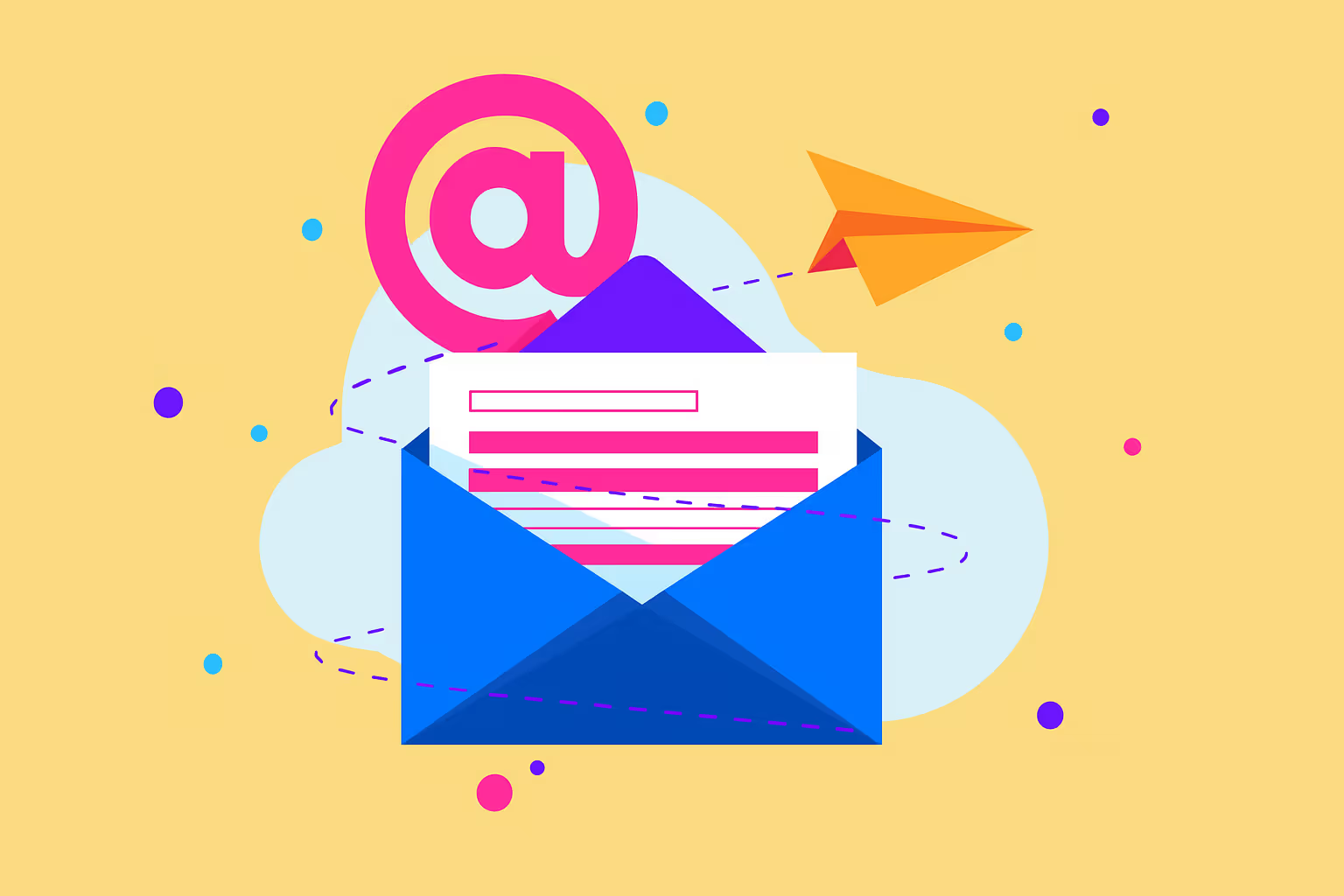
Not all leads are ready to buy on day one—and that's where drip campaigns come in. These automated sequences deliver a series of emails over time, gradually warming up prospects until they’re ready to take action.
Start by segmenting your email list based on:
Each segment should receive content tailored to their specific pain points and interests. A startup founder might appreciate case studies, while a procurement officer may want ROI calculators or pricing transparency.
Drip campaigns can also be triggered by user actions—like form submissions, page views, or inactivity. This ensures your outreach stays timely and relevant, rather than feeling like spam.
To do email marketing well, you need more than just Mailchimp or Constant Contact. A full-fledged CRM and marketing automation system—like HubSpot, ActiveCampaign, or Nutshell—lets you:
For startups on a lean budget, tools like MailerLite or Brevo (formerly Sendinblue) offer automation at a more accessible price point.
Close used segmented email nurturing and behavior‑based triggers to boost conversions—nurtured leads make purchases that are 47 % larger than non‑nurtured ones, with workflow automation guiding leads through each funnel stage.
When implemented well, email doesn’t just move leads down the funnel—it creates trust, authority, and top-of-mind presence. And for startups with limited sales bandwidth, that kind of scale is invaluable.
When you're a startup trying to break through the noise, organic growth alone can feel painfully slow. That’s where performance marketing—particularly paid ads—comes in. It allows you to fast-track visibility, generate leads on demand, and test your messaging in real time. For B2B startups, paid advertising isn’t about spraying ads everywhere; it’s about precision targeting, smart budgeting, and continuous optimization.
Let’s start with the platforms that matter most for B2B: Google and LinkedIn.
Google Ads gives you direct access to high-intent leads. When someone searches for “project management tool for remote teams” or “B2B payment automation,” they’re actively seeking a solution. With the right keywords, landing pages, and bid strategies, you can appear exactly when your product is top of mind.
LinkedIn Ads offers unmatched B2B targeting capabilities. You can segment by company size, industry, job title, seniority, and more. Sponsored InMail, lead gen forms, and carousel ads let you deliver tailored content to specific decision-makers.
To get the most from your campaigns:
Start small. A $500 test budget on LinkedIn with a highly specific audience and offer can teach you more than a month of guessing.
Many B2B buyers visit your site multiple times before reaching out. Retargeting ensures you stay visible during that window of indecision. With platforms like Google Display Network, LinkedIn, and Meta, you can serve personalized ads to previous visitors or people who interacted with your brand.
Pair this with account-based marketing (ABM) to zero in on high-value companies. Tools like RollWorks, Demandbase, or even custom LinkedIn targeting allow you to deliver ads, emails, and landing pages designed for specific firms or industries.
Metadata.io helped SaaS startup G2 reduce their cost‑per‑lead (CPL) by 42% using hyper-targeted LinkedIn Conversation Ads powered by G2 Buyer Intent data (sell.g2.com). That resulted in an average CPL drop from $187 to $109, a 12% higher conversion rate, and an 18% increase in average deal size.
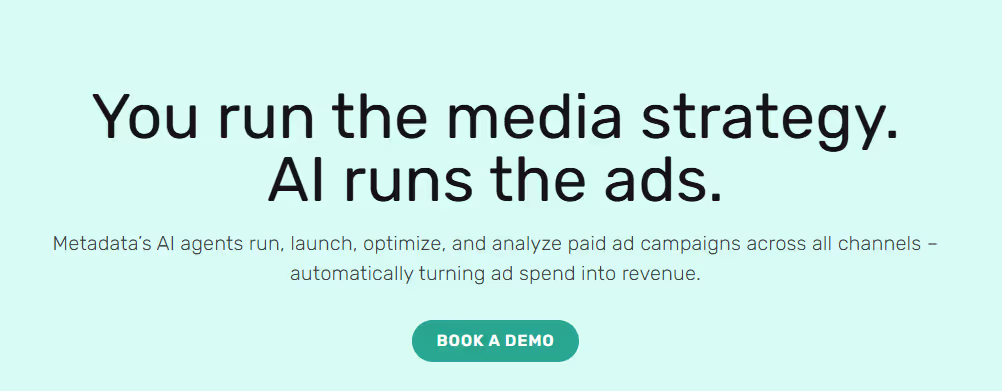
Performance marketing is where creativity meets data. For B2B startups, it’s not about chasing clicks—it’s about capturing attention at the right time, with the right message, in front of the right people.
In the B2B world, trust is currency—and few tactics build trust faster than a recommendation from someone your audience already respects. That’s why influencer and partner marketing are becoming indispensable strategies for startups. They allow you to tap into established audiences, amplify your brand, and accelerate trust-building without waiting for years of content to do the job.
While “influencer marketing” might evoke images of Instagram celebrities, in B2B, it’s a completely different game. The most effective B2B influencers aren’t chasing likes—they’re industry insiders, analysts, consultants, engineers, or subject matter experts with loyal, often niche, followings.
What makes them so powerful is their contextual credibility. When a cybersecurity founder endorses a new SaaS security tool, their network listens. And their endorsement carries far more weight than any paid ad ever could.
To get started:
Startups like Gong, Lavender, and Chili Piper have grown by leaning into these types of relationships. Their founders routinely appear on podcasts, post candid insights on LinkedIn, and co-create content with industry peers.
Partnerships go beyond individuals. Co-marketing with complementary businesses can help you break into new audiences and double the reach of your campaigns.
Examples of strong B2B co-marketing include:
Effective partnerships benefit both parties and their audiences. They're not just about cross-promotion—they’re about value creation.
For instance, Webflow partnered with LottieFiles to provide motion design templates and tutorials that benefited both their users. The result was more than just content—it was a shared customer experience.
Influencer and partner marketing let startups borrow trust. When used strategically, they help you build relationships that would otherwise take years to develop on your own.
Referrals are still one of the most powerful drivers of B2B growth—and for startups, they can become an invaluable channel early on. Meanwhile, online reputation acts as digital word-of-mouth. When decision-makers are comparing vendors, the company with more positive reviews, testimonials, and client stories almost always comes out on top.
A well-structured referral program encourages your happiest customers to spread the word—and rewards them for it. Whether it’s discounts, extended service, or exclusive access to features, even a simple incentive can go a long way in B2B.
How to build a referral engine that works:
Startups like Dropbox, Airtable, and Typeform all saw explosive early growth due in part to simple referral programs that empowered their earliest users to share.
Your reputation is your most valuable marketing asset. According to a G2 survey, 92% of B2B buyers are more likely to purchase after reading a trusted review.
Here’s how startups can build and showcase their credibility:
Also, don’t be afraid to address mixed or negative feedback. How you handle criticism often speaks louder than a perfect track record.
One excellent example is ClickUp. They grew rapidly by building a library of detailed customer testimonials and video case studies—each highlighting different use cases and verticals. This content helped accelerate sales cycles and build social proof in crowded markets.
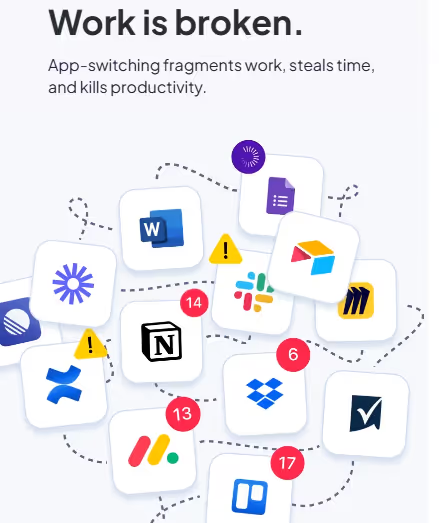
In a digital-first world, reputation is your trust accelerant. Smart referral and reputation strategies not only attract new leads—they compound over time, creating a defensible moat around your brand.
What gets measured gets managed—and in digital marketing, what gets tested gets better. For B2B startups operating in fast-moving environments with lean teams, analytics and experimentation aren’t optional. They’re how you stretch every dollar, refine your messaging, and identify what actually drives growth.
Let’s start with the numbers that matter most to B2B growth:
Other important metrics include website conversion rate, email open/click rates, content engagement time, and funnel progression. Use tools like Google Analytics 4, HubSpot, and Hotjar to capture both macro trends and micro interactions.
High-performing B2B marketers don’t rely on guesswork—they test everything. From subject lines to landing page layouts, every interaction is an opportunity to learn and optimize.
A/B testing tips:
Platforms like Optimizely, Google Optimize (now sunsetting), or VWO are ideal for startups ready to scale testing. Email tools like Mailchimp and ActiveCampaign also support native A/B capabilities.
Dashboards: Use tools like Databox, Looker Studio (formerly Google Data Studio), or built-in CRM dashboards to monitor performance in real time. This gives stakeholders transparency and helps marketing teams act on data, not instinct.
In the world of digital marketing, your edge lies not in spending more—but in learning faster. Optimization is how B2B startups transform limited resources into scalable growth engines.
For many B2B startups, the instinct is to go all-in on digital—which makes sense. It’s scalable, cost-effective, and measurable. But in reality, many high-value B2B relationships still begin or are solidified through offline interactions. The smartest marketers don’t treat these channels as separate—they build bridges between them.
Whether it’s attending industry trade shows, hosting workshops, or participating in niche roundtables, face-to-face experiences offer a level of trust and rapport that digital alone can’t replicate. But the magic happens when offline moments are captured and extended online.
Here’s how to create that integration:
Real-world example: Drift pioneered “conversational marketing” by hosting large-scale, in-person events—most notably their HYPERGROWTH conference in cities like San Francisco, Boston, and London. With around 1,750+ attendees per event, these gatherings focused on real human connections. Drift then amplified the moments with follow-up digital content, podcasts, and retargeted campaigns that extended engagement well beyond the event day.
Even as B2B decision-making becomes more digital, offline touchpoints still hold power—especially when they’re tightly integrated into your digital marketing ecosystem.
By aligning both realms, startups can drive deeper relationships, reinforce brand credibility, and maximize ROI from every touchpoint.
Even with the best intentions and a strong digital strategy, many B2B startups fall into predictable traps. These mistakes don’t just waste time—they drain budgets, stall momentum, and sometimes even erode early credibility. Knowing what not to do is just as important as knowing what works.
Putting all your eggs in one basket—be it SEO, LinkedIn, or Google Ads—is risky. Digital channels are volatile. Algorithms change, costs rise, and what worked last quarter might not work next month.
Diversify your acquisition strategy across search, paid media, email, social, and partnerships. That way, if one channel underperforms, your pipeline doesn’t dry up overnight.
Many startups jump straight to CTAs like “Book a Demo” without first educating or engaging their prospects. This rush can feel pushy—especially in long B2B sales cycles.
Instead, use gated content, drip emails, and webinars to build familiarity and trust. Let the prospect warm up to your brand before expecting a conversation with sales.
The middle of the funnel—where leads are evaluating options—is often the most underutilized. Yet it’s here where well-timed, insightful content can push buyers toward you.
Focus on nurturing content: case studies, comparison guides, email sequences, retargeting campaigns. Support the buying committee as they do internal homework.
If your marketing team is sending unqualified leads to sales—or if sales is unaware of active campaigns—deals will fall through the cracks. Early alignment between teams ensures a smoother journey for prospects and a higher close rate.
Use shared dashboards, regular syncs, and clearly defined lead scoring criteria to stay in lockstep.
Don’t assume your messaging, offers, or personas are correct—validate them. A/B test your landing pages. Run feedback sessions with early customers. Track content performance. Data is your early-stage compass.
Even small tweaks based on real feedback can dramatically improve ROI.
Startups move fast, but strategy still matters. Avoiding these missteps won’t guarantee success—but it will remove the most common blockers to sustainable, scalable digital growth.
Highlighting real-world examples grounds this guide in reality—and shows that these strategies aren’t just theory.
Clearbit launched a microsite called "Data-Driven Sales" in collaboration with Campfire Labs. Featuring in‑depth interviews and sales content, the microsite:
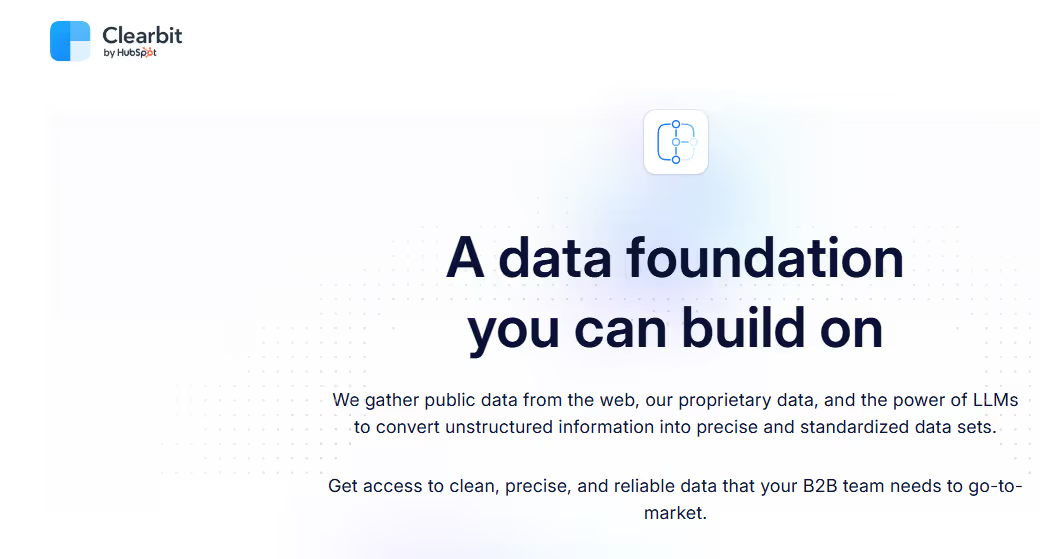
By focusing on niche, high-value content aligned with their ICP, Clearbit positioned itself as a trusted B2B sales authority—turning prospects into revenue.
Zapier implemented A/B testing for SEO, inspired by practices from companies like Pinterest. By optimizing page copy and metadata, they increased organic traffic significantly. Asad Zulfahri, Zapier’s SEO lead, noted that mastering SEO "eliminate[s] the need for PPC to grow" and drove profitable scale. This method helped Zapier shift from paid dependency to a strong, cost-effective organic engine.
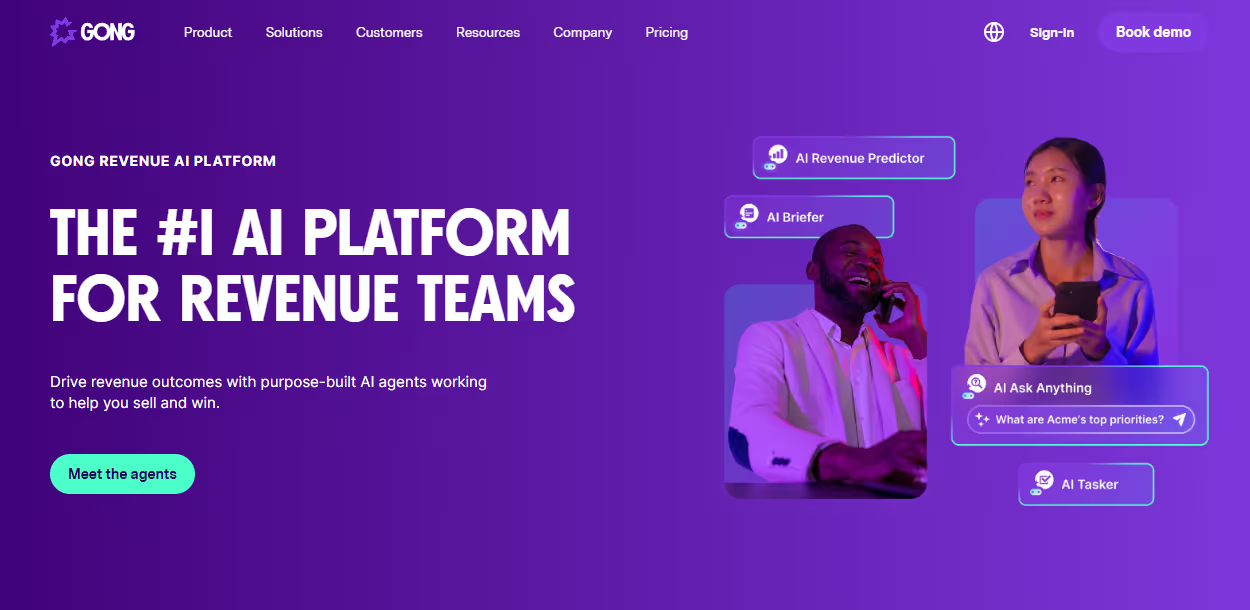
a. Paid Ads & Experimentation:
Gong’s Google Ads program saw a 95% quarter-over-quarter increase in enterprise pipeline, 33% YoY improvement in ROAS, and 32% YoY pipeline growth—without increasing ad spend. Gong aligns search queries with SDR follow-ups for tailored outreach.
b. Content Strategy:
Gong adopted a data-driven content approach—publishing original research (e.g., insights from millions of calls), podcasts, interactive tools, and executive thought-leadership. This positioned Gong as the definitive authority in sales intelligence.
c. Brand-Building with Bold Campaigns:
Their Super Bowl commercial targeted B2B audiences by showing up where decision-makers actually watched TV—generating 400+ mentions over five days and breaking inbound records.
These examples highlight how disciplined, tactical SEO can fuel explosive growth for startups.
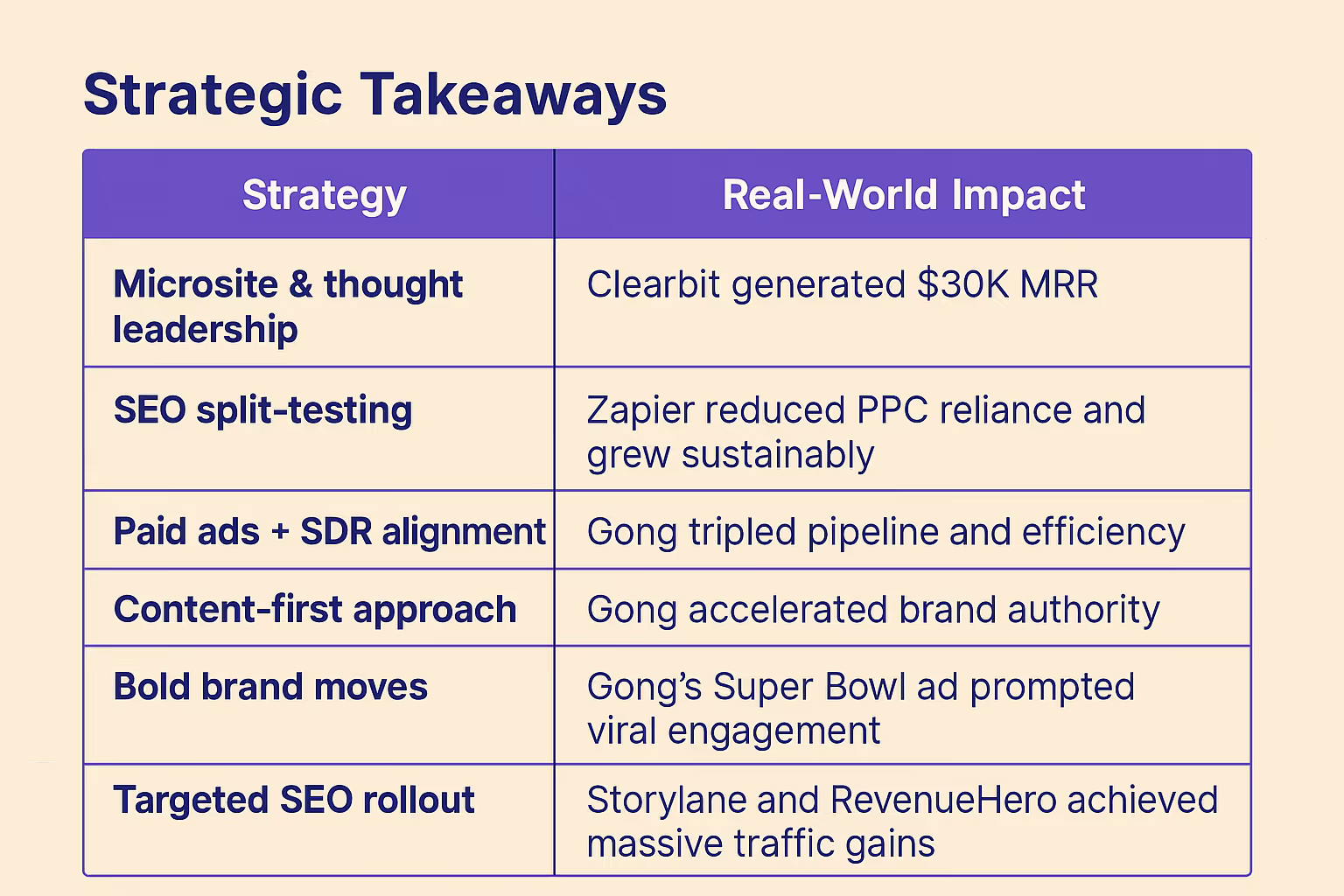
These case studies illustrate what’s possible when startups align digital strategies—across SEO, content, advertising, and brand—to accelerate growth intentionally.
Content marketing, paired with SEO, often delivers the most sustainable ROI over time. It helps you rank for relevant searches, builds authority in your niche, and nurtures long-term brand equity. While paid ads can generate immediate results, organic traffic is a more cost-effective long-term strategy.
Success should be tracked across multiple metrics: Customer Acquisition Cost (CAC), Customer Lifetime Value (CLV), Return on Ad Spend (ROAS), and Sales Qualified Leads (SQLs). These data points tell you how efficiently your marketing drives real business outcomes.
Use tools like Google Analytics 4, HubSpot, or Looker Studio to build dashboards and monitor performance in real time.
No. While LinkedIn is essential, especially for targeting decision-makers, platforms like YouTube, X (formerly Twitter), and even Reddit can be powerful depending on your audience. The key is to be where your buyers are—and tailor your messaging to each platform's unique tone and behavior.
Start by clarifying your brand positioning and narrowing your ICP (ideal customer profile). Then invest in high-quality content, SEO, and creative campaigns that challenge industry norms. Differentiation isn't just about what you sell—it’s how you communicate your value.
Being bold, consistent, and helpful can cut through the noise more effectively than product specs alone.
Once you're generating leads consistently and have at least one repeatable sales process, it’s time to consider automation. This allows you to scale outreach, reduce manual follow-up, and personalize communication at scale. Early adoption tools like MailerLite or ActiveCampaign offer a low-cost way to get started.
Because digital marketing isn’t one-size-fits-all—especially in the B2B startup space. Ballistic Design Studio specializes in helping early-stage companies launch high-converting websites, define their digital brand, and scale with strategic marketing systems tailored to your growth phase.
From SEO and performance marketing to content and design, Ballistic bridges creativity with performance, helping B2B startups hit their first meaningful milestones faster.
Explore how Ballistic Design Studio can transform your startup’s digital marketing
For B2B startups, digital marketing isn’t just a support function—it’s the growth engine that powers visibility, credibility, and conversion. In today’s hyper-competitive markets, simply having a great product isn’t enough. You need to be discovered, trusted, and chosen—repeatedly.
The strategies we’ve covered—from SEO and content marketing to performance advertising, influencer outreach, and email automation—aren’t about quick wins. They’re about building a durable, data-backed system that connects your solution with the right buyers at the right time.
But here’s the reality: implementation matters just as much as strategy. Many startups know what to do, but struggle to do it well. That’s where expert partners can make all the difference.
Ballistic Design Studio works closely with startups to develop and execute digital marketing strategies that don’t just attract traffic—they drive pipeline. With a focus on clean design, performance optimization, and strategic clarity, Ballistic empowers B2B founders to punch above their weight from day one.
If you're ready to turn your digital presence into a competitive advantage, visit Ballistic Design Studio and take the first step toward scalable, sustainable growth.

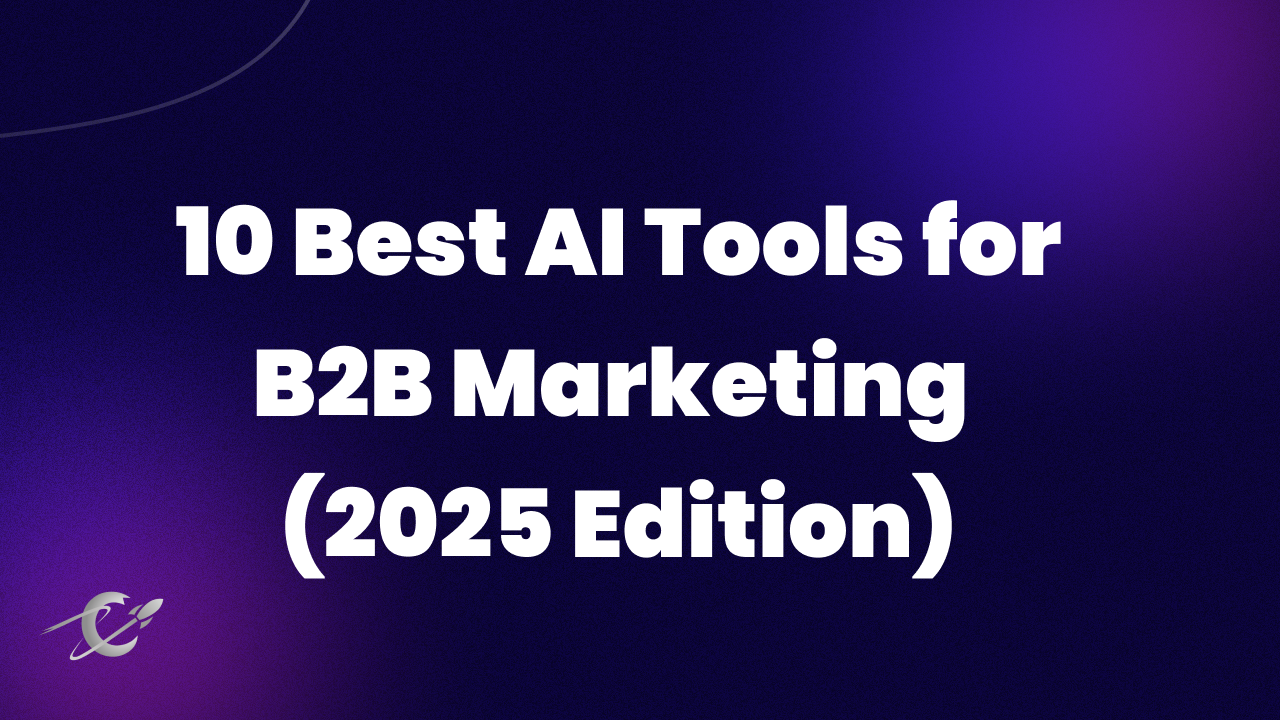
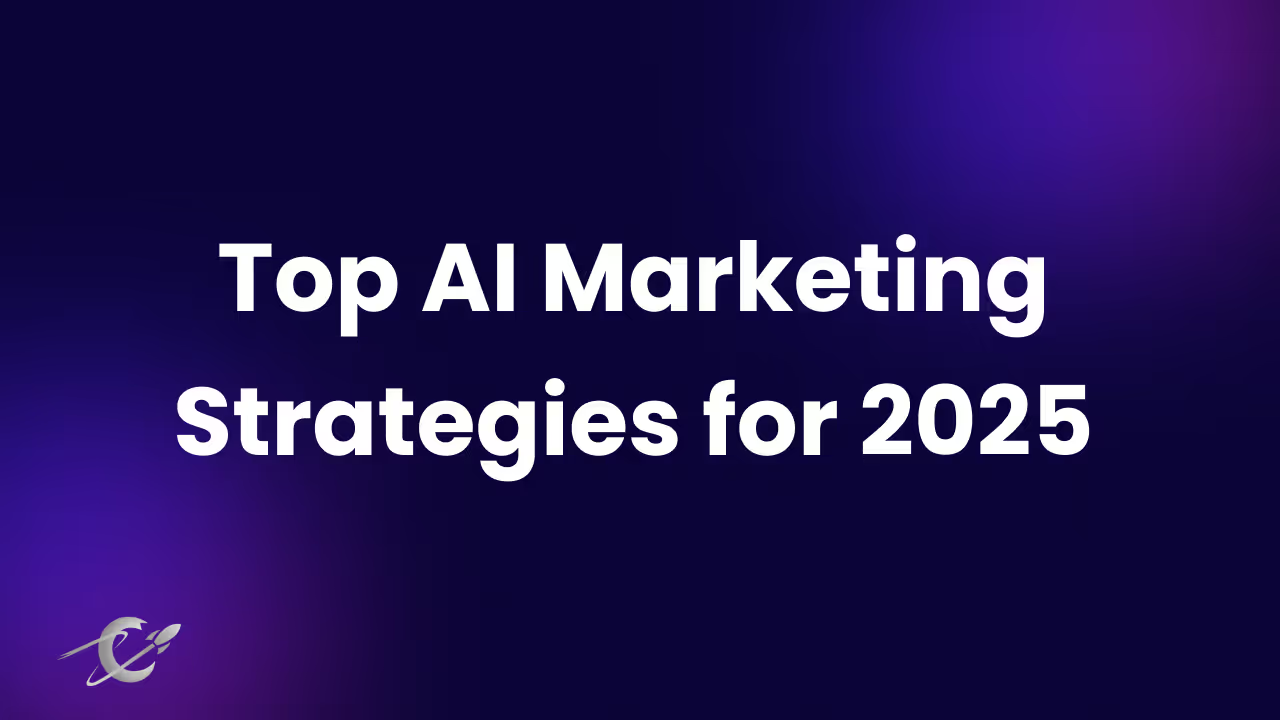
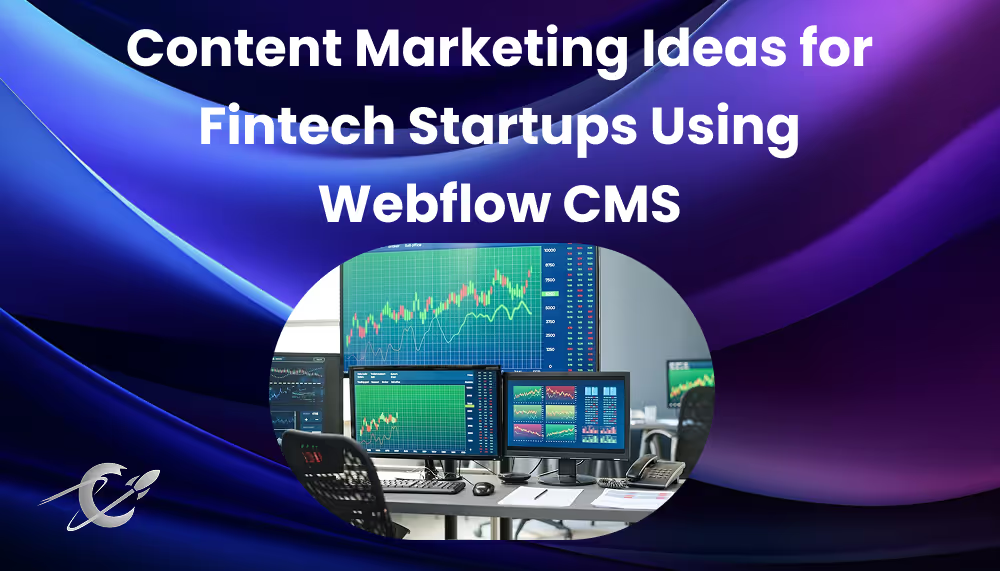
Wait, don't go! 100% Free - Unlimited Webflow Development for 7 days.
Only valid for-